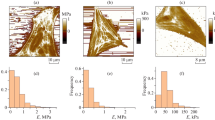Abstract
The first attempt is made at applying the method of atomic force microscopy (AFM) for determining the molecular mechanisms of intracellular signalization with the participation of Na+, K+-ATPhase playing an important role of a signal transductor (amplifier). The AFM method combined with the organotypic cultivation makes it possible to obtain quantitative information on the Young moduli of living neurons and cells subjected to the action of very low concentrations of ouabain. This substance is known to trigger in this case the intracellular signalization processes by transferring a molecular signal to the genome of a cell. The cell response is manifested in a sharp intensification of protein synthesis accompanied by a rearrangement of the cytoskeleton and activation of enzyme signal pathways in a cytosol. AFM measurements of the images of the cell surface relief are performed using the PeakForce quantitative nanomechanical properties mapping PeakForce QNM mode. The Young moduli of control neurons and of sensory neurons under the action of ouabain are measured simultaneously. It is found that the activation of the signal-transducing function of Na+, K+-ATPhase triggers intracellular signal cascades, which increase the cell stiffness. The application of the AFM method in further studies of the mechanisms of intracellular molecular processes appears as promising. Its combination with inhibitory analysis will clarify the role of individual molecules (e.g., a number of ferments) in regulation of growth and development of living organisms.
Similar content being viewed by others

References
Z. Xie, Cell Mol. Biol. 47, 383 (2001).
L. V. Borovikova, D. V. Borovikov, V. V. Ermishkin, and S. V. Revenko, Prim. Sens. Neuron. 2, 65 (1997).
M. S. Gold, D. B. Reichling, M. J. Shuster, and J. D. Levine, Proc. Natl. Acad. Sci. USA 93, 1108 (1996).
B. V. Krylov, A. V. Derbenev, S. A. Podzorova, M. I. Lyudyno, A. V. Kuz’min, and N, L, Izvarina, Neurosci. Behav. Physiol. 30, 431 (2000).
E. V. Lopatina, I. L. Yachnev, V. A. Penniyaynen, V. B. Plakhova, S. A. Podzorova, T. N. Shelykh, I. V. Rogachevsky, I. P. Butkevich, V. A. Mikhailenko, A. V. Kipenko, and B. V. Krylov, Med. Chem. 8, 33 (2012).
J. M. Hamlyn, B. P. Hamilton, and P. Manunta, J. Hypertens. 14, 151 (1996).
H. J. Butt, E. K. Wolff, S. A. Gould, B. Dixon Northern, C. M. Peterson, and P. K. Hansma, J. Struct. Biol. 105, 54 (1990).
W. Haberle, J. K. Horber, and G. Binnig, J. Vac. Sci. Technol. 9, 1210 (1991).
F. Braet and C. Rotsch, Appl. Phys. A 66, 575 (1998).
X. Chen, L. Feng, H. Jin, S. Feng, and Y. Yu, Clin. Hemorheol. Microcirc. 43, 243 (2009).
J. Domke, W. J. Parak, M. George, H. E. Gaub, and M. Radmacher, Eur. Biophys. J. 28, 179 (1999).
E. Henderson, P. G. Haydon, and D. S. Sakaguchi, Science 257, 1944 (1992).
R. Nowakowski, P. Luckham, and P. Winlove, Biochim. Biophys. Acta 1514, 170 (2001).
C. Rotsch and M. Radmacher, Biophys. J. 78, 520 (2000).
E. Spedden and C. Staii, Int. J. Mol. Sci. 14, 16124 (2013).
F. X. Jiang, D. C. Lin, F. Horkay, and N. A. Langrana, Ann. Biomed. Eng. 39, 706 (2011).
M. Mustata, K. Ritchiea, and H. A. McNally, J. Neurosci. Methods. 186, 35 (2010).
V. A. Penniyainen, I. L. Yachnev, A. V. Kipenk, E. V. Lopatina, and B. V. Krylov, Sens. Sist. 28, 90 (2014).
Author information
Authors and Affiliations
Corresponding author
Additional information
Original Russian Text © A.V. Ankudinov, M.M. Khalisov, V.A. Penniyainen, S.A. Podzorova, B.V. Krylov, 2015, published in Zhurnal Tekhnicheskoi Fiziki, 2015, Vol. 85, No. 10, pp. 126–130.
Rights and permissions
About this article
Cite this article
Ankudinov, A.V., Khalisov, M.M., Penniyainen, V.A. et al. Application of atomic force microscopy for studying intracellular signalization in neurons. Tech. Phys. 60, 1540–1544 (2015). https://doi.org/10.1134/S1063784215100047
Received:
Published:
Issue Date:
DOI: https://doi.org/10.1134/S1063784215100047


